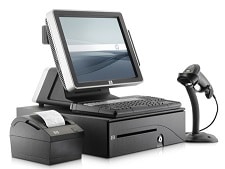
What Is A Point Of Sale System?
The most important characteristics of a cutting-edge system are that it has advanced features but is still designed to be easy to use. All POS systems can check out customers, print receipts, and keep track of your inventory counts. But not all can do complex operations such as handling discounts, taxes, returns, credits, add-on fees, price breakpoints, sale specials, and currency conversion all in the same transaction. Not all can integrate your online and in-store operations while tracking the clients and revenues from both.
Indeed until very recently, this was only available to big box stores with their own IT staff. Even now retailers who want integrated e-commerce are routinely quoted up to $25,000 or more. Yet it is possible to have it all, do it on a budget, and with basic computer skills. You can build a POS system and here is what you should know before diving in:
What Should A POS System Include?
More than just a smart cash register it is an entire retail management package. In addition to the usual POS functions, a good system can do the following:
– Bring advanced inventory control with artificial intelligence features that can suggest the correct re-order quantities.
– Maintain your data on your own computers while using the cloud for automatic backups.
– Track each client’s detailed history including any serialized products like electronics or high-end bikes.
– Switch easily between regular sales and on-account sales, or between printing receipts and full-page invoices.
– Associate product photos with any inventory records.
– Enforce staff security access levels.
– Combine the operation of your sales counter and online webshop.
– Create a wide variety of reports that assist in making smart merchandising and cash flow decisions.
The last one is of crucial for business growth.
Learn More About The Benefits Of A POS System….
What Are The Benefits Of A Good POS System?
– Valuable business insights. In the old days, retailers spent a lot of time trying to determine what works and what doesn’t. Now all kinds of detailed information about your products, clients, staff, suppliers, and financials are available at the push of a button.
– Speed and accuracy. Items are checked out faster, priced correctly, and counted accurately.
– Streamlined workflow. Re-ordering stock and tracking cash flow are much less time-consuming.
– Eliminate costly errors. Less merchandising guesswork, over or under stock, less shrinkage, tighter control over the sales counter.
– Customer relations management. Create loyalty by offering reward points and collecting customer data to use in marketing campaigns.
Can I Build A POS System?
Getting started: The good news is that it’s pretty easy and it won’t cost a lot. To get started you will need any Windows computer, laptop, or tablet and some optional devices. You can build a POS system with just a computer, an inkjet printer, and Retail Plus Point Of Sale software.
This is enough to start selling and printing invoices. The optional devices are used to streamline the process and create a regular checkout experience for the customer. They include an automatic cash drawer, a receipt printer, and a barcode scanner. These are called “POS hardware” and there is something you should know about them.
The well-kept little secret: You can buy POS hardware for the same price as any point of sale systems dealer can. Receipt printers, cash drawers, and barcode scanners are all commodities and can be ordered online from Amazon, Office Depot, or Staples. To build a POS system is no more difficult and in some cases easier, than installing a printer. Planning to build a POS system has never been easier.
What to buy: In order to build a POS system, it’s important to understand that POS hardware is all pretty generic in that the different brands work in substantially the same way. When shopping for hardware look for the following:
– Epson or Star USB receipt printers. Get a “thermal” model. These are faster and quieter than the impact or inkjet printers.
– AFP automatic cash drawers. These plug into the back of the receipt printer and are actually triggered from a port on the printer.
– Symbol or Metrologic USB barcode scanners. They come in two basic types – CCD and laser scanners. The CCD scanners are cheaper but you have to be closer to the barcode label to read them.
Getting it all working: Here is the easiest part when you build a POS system. Once you have the hardware on-site just call us at 888-272-4874 and we will provide all the help, guidance, and advice you need at no extra charge. It’s all pretty easy to set up and you will be checking out customers before you know it.



